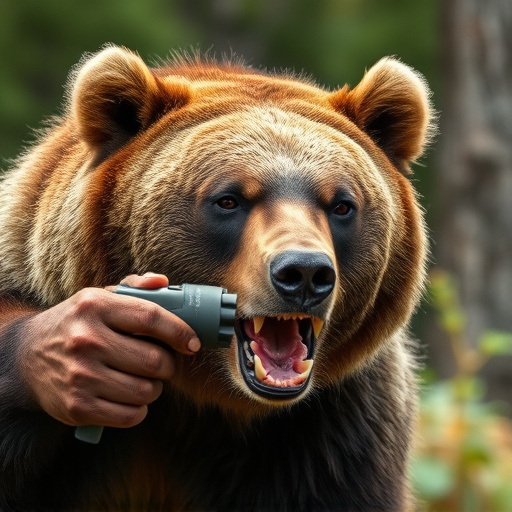Understanding grizzly bear behavior, recognizing charge signals, and correctly storing bear spray (at temperatures below 70°F/21°C) are key safety measures in wilderness areas. Maintaining spray effectiveness via ideal temperature ranges (-20°F/-29°C to 80°F/27°C) ensures reliable protection against charging bears. Combining these with noise-making, waste management, and awareness can enhance safety in grizzly bear habitats.
In the vast wilderness, encountering a charging grizzly bear can be a terrifying reality. Understanding their behavior and knowing how to defend yourself is crucial for adventurers and outdoor enthusiasts. This article equips you with essential knowledge to navigate these dangerous situations. From deciphering bear charging patterns to exploring alternative safety measures, we delve into effective strategies. Learn about the science behind bear spray, its active ingredients, and optimal storage techniques, including the proper temperature, to ensure maximum protection in the wild.
- Understanding Grizzly Bear Behavior and Their Charging Patterns
- The Role of Environment: When and Where Bears Charge
- Choosing the Right Bear Spray: Active Ingredients and Effectiveness
- Proper Storage Techniques to Maintain Optimal Bear Spray Performance
- Beyond Bear Spray: Additional Wilderness Safety Measures Against Charging Grizzlies
Understanding Grizzly Bear Behavior and Their Charging Patterns
Grizzly bears are powerful and unpredictable animals, and understanding their behavior is crucial for anyone venturing into their wilderness habitat. When a grizzly bear charges, it’s often a reaction to perceived threats or a display of dominance rather than an aggressive attack. They can run at speeds up to 35 miles per hour, making them formidable opponents. By recognizing the signs that precede a charge—such as growling, stomping, and swatting at the ground—you can take appropriate evasive action.
Knowing when and where to deploy bear spray is also essential. The proper temperature for storing bear spray is vital to ensure its effectiveness. Typically, it should be kept below 120°F (49°C) to maintain optimal performance. Understanding these factors can significantly enhance your safety during encounters with grizzly bears in their natural environment.
The Role of Environment: When and Where Bears Charge
In the vast wilderness, understanding the behavior and triggers that incite bear charges is paramount for safety. Environmental factors play a significant role in predicting when and where bears might become aggressive. Generally, grizzly bears charge when they feel threatened or surprised, especially during times when food sources are scarce. They are most active during dawn and dusk, periods known as “crucial times” by wildlife experts, when their senses are heightened for potential prey or dangers.
The proper storage of bear spray, a crucial defense mechanism, should consider the environment. It is recommended to store it in cool, dry places with temperatures below 70°F (21°C) to maintain its effectiveness. This ensures that when a hiker or camper needs it most, during an unexpected encounter, the spray will perform optimally, providing a critical layer of protection against charging bears.
Choosing the Right Bear Spray: Active Ingredients and Effectiveness
When it comes to protecting yourself from a charging grizzly bear, choosing the right bear spray is paramount. Look for a spray containing capsaicin, the active ingredient found in chili peppers, which is proven effective in deterring bears. The concentration of capsaicin should be at least 1.5% for maximum effectiveness. Check the label for specific instructions on usage and range – remember, it’s crucial to practice using the spray before venturing into bear country.
Proper storage of your bear spray is equally important. Most manufacturers recommend storing sprays in temperatures between -20°F and 120°F (-29°C to 49°C). Extreme heat or cold can diminish the spray’s effectiveness, so avoid leaving it in your vehicle during summer days or winter nights. Store it in a readily accessible location, close at hand for quick deployment if needed.
Proper Storage Techniques to Maintain Optimal Bear Spray Performance
When it comes to wilderness safety against charging grizzly bears, proper storage techniques are often overlooked but are crucial for ensuring the effectiveness of your bear spray. Bear spray is a powerful deterrent when used correctly, and maintaining its optimal performance starts with suitable storage conditions. The key factor here is temperature control. Ideally, bear spray should be stored at temperatures between 5°F (-15°C) and 80°F (27°C). Extreme heat or cold can degrade the spray’s chemical composition, reducing its potency.
Avoid leaving your bear spray in direct sunlight or near heating sources during cold months. Similarly, do not store it in frozen areas as the pressure can build up inside the canister, causing potential issues upon use. Maintaining the correct storage temperature is a simple yet effective way to guarantee that your bear spray will perform reliably when you need it most during encounters with aggressive bears.
Beyond Bear Spray: Additional Wilderness Safety Measures Against Charging Grizzlies
When venturing into wilderness areas known for grizzly bear populations, relying solely on bear spray isn’t enough. While effective at close range, its success depends on proper usage and accessibility – factors that can be compromised in high-stress situations. Therefore, seasoned outdoor enthusiasts and guides advocate for a multi-layered approach to bear safety.
Beyond carrying bear spray, key strategies involve making noise to deter bears while hiking (especially in dense vegetation), minimizing potential food sources by properly storing and disposing of waste, and being mindful of your surroundings at all times. Ensuring your bear spray is stored at the proper temperature – usually between -20°C and 40°F – is crucial for optimal performance when needed. Additionally, knowing local bear behavior patterns and understanding the ‘danger zone’ distances can offer valuable seconds during an encounter.
When navigating wilderness areas known for grizzly bear populations, understanding their behavior and taking proactive safety measures are key. By knowing the environmental cues that trigger charges and equipping yourself with effective bear spray, you significantly enhance your safety. Remember, proper storage techniques, including ideal Proper Temperature for Bear Spray Storage, ensure its longevity and reliability when needed most. Combining these strategies with awareness and respect for wild bears fosters a safer outdoor experience in their habitat.
